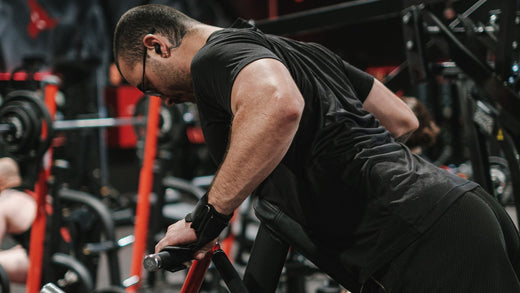
When to Start Using Lifting Straps in Your Workout Routine
Share
Lifting straps are a game-changer for weightlifters, especially those looking to take their training to the next level. However, knowing when and how to use them is key to maximising their benefits while avoiding dependency.
This guide will help you understand when to incorporate lifting straps into your workout routine and how they can support your progress.
When to Start Using Lifting Straps
Knowing the right time to introduce lifting straps is essential for balanced progression. Here are some key scenarios when you might consider adding them to your routine:
1. When Grip Strength Limits Your Performance
If your grip gives out before the target muscle group does during heavy lifts, it can hold back your overall progress. This is common in exercises like:
- Deadlifts
- Barbell or dumbbell rows
- Pull-ups or chin-ups
Lifting straps allow you to focus on the larger muscle groups without worrying about grip failure. This helps you maintain proper form and complete your sets with confidence.
2. During High-Volume or Intense Workouts
On days when your workout involves higher repetitions or exceptionally heavy weights, grip fatigue can creep in quickly. This often happens during:
- Back-to-back pulling exercises
- Extended drop sets or supersets
- High-rep deadlift challenges
Using lifting straps during these sessions gives your grip a break, so you can keep your intensity up and finish strong without sacrificing your performance.
3. To Prevent Grip-Related Injuries
Straining your grip excessively over time can lead to issues such as:
- Wrist discomfort
- Tendon overuse injuries
- Blisters or skin tears
Lifting straps help distribute the load more evenly, reducing the strain on your hands and wrists. This protective measure is particularly useful during demanding phases of training or recovery periods.
4. When Training for Strength Over Grip
If your main goal is to build strength in large muscle groups like your back, traps, or hamstrings, grip shouldn’t be the limiting factor. For instance:
- Heavy rack pulls
- Romanian deadlifts
- Weighted pull-ups
Lifting straps allow you to shift the focus entirely to these muscles, helping you lift heavier and achieve greater gains without worrying about grip endurance.

Benefits of Using Lifting Straps for Better Workouts
Incorporating lifting straps at the right time can unlock a range of benefits that enhance your overall performance and safety in the gym:
Improved Lift Performance
Lifting straps enable you to focus entirely on the target muscle group by removing grip strength as a limiting factor. This is especially beneficial during exercises like deadlifts, rows, and shrugs where the grip often gives out first.
Increased Training Volume
Straps allow you to push through more reps and sets without your grip fatiguing prematurely. This lets you maintain intensity and hit the desired training volume for better muscle growth and endurance.
Enhanced Muscle Isolation
With the support of lifting straps, you can better isolate specific muscle groups. This is crucial when performing movements designed to target the back, traps, or hamstrings.
Injury Prevention
By reducing the strain on your hands, wrists, and forearms, lifting straps help prevent overuse injuries, blisters, and tendon issues. They’re particularly useful during periods of heavy training or recovery from minor grip-related injuries.
How to Use Lifting Straps Effectively
Using lifting straps correctly ensures maximum benefits while minimising the risk of improper use. Follow these steps:
Position the Strap Correctly:
- Loop the strap securely around your wrist.
- Ensure it’s snug but not too tight to allow proper circulation.
Wrap Around the Bar:
- Thread the loose end of the strap around the barbell, dumbbell, or pull-up bar.
- Wrap it a couple of times to ensure a secure grip.
Tighten for Grip:
- Once wrapped, pull the strap tight around the bar.
- Ensure it provides a firm grip without feeling restrictive.
Maintain Proper Form:
- Avoid over-relying on the straps to compensate for poor lifting technique.
- Focus on maintaining proper posture and movement patterns during every lift.

Situations Where You Should Avoid Using Lifting Straps
While lifting straps are incredibly helpful, there are situations where their use should be limited:
Developing Grip Strength:
- Avoid straps during lighter sets, warm-ups, or grip-focused exercises like farmer’s carries.
- Building natural grip strength is essential for overall functionality and long-term progress.
Beginners:
- Early-stage lifters should prioritise learning proper form and building foundational strength before relying on lifting accessories.
- Mastering technique without straps ensures better control and muscle engagement.
Overuse:
- Using lifting straps excessively can hinder natural grip strength progression over time.
- Reserve them for specific situations like heavy lifts, high-rep sets, or when grip failure limits performance.
Maximise Your Training with Balanced Strap Use
Lifting straps can be a game-changer in your fitness journey when used strategically. They’re perfect for breaking through plateaus, handling heavier loads, and reducing the risk of injuries. However, maintaining balance is essential. Avoid neglecting grip strength development or becoming overly reliant on this tool.
Get in touch with us and incorporate lifting straps thoughtfully into your routine to complement your grip training and unlock your full potential. With the right approach, you can elevate your performance and achieve a new personal best in no time.
